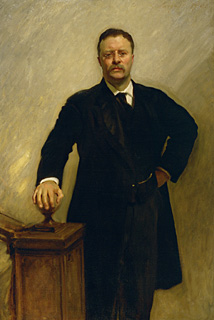
The official White House portrait of
President Theodore Roosevelt
John Singer Sargent (1856–1925)
Oil on canvas, 1903
The White House, Washington, D.C.

 |
At the invitation of the first family, John Singer Sargent was a White House guest for a week in the middle of February 1903, while he painted a portrait of the President. For Sargent, the foremost Anglo-American portraitist of his era, the experience was vexing in many respects. Particularly, Sargent found the President's strong will daunting from the start. The choice of a suitable place to paint, where the lighting was good, tried Roosevelt's patience. No room on the first floor agreed with the artist. When they began climbing the staircase, Roosevelt told Sargent he did not think the artist knew what he wanted. Sargent replied that he did not think Roosevelt knew what was involved in posing for a portrait. Roosevelt, who had just reached the landing, swung around, placing his hand on the newel and said, "Don't I!" Sargent saw his opportunity and told the President not to move; this would be the pose and the location for the sittings. Still, over the next few days Sargent was frustrated by the President's busy schedule, which limited their sessions to a half-hour after lunch. Sargent would have liked to have had more time. Nevertheless, Roosevelt considered the portrait a complete success. He liked it immensely, and continued to favor it for the rest of his life. Commissioned by the federal government, Sargent's Roosevelt is the official White House portrait of the twenty-sixth President.
The official White House portrait of President Theodore Roosevelt John Singer Sargent (1856–1925) Oil on canvas, 1903 The White House, Washington, D.C. |
Past Exhibitions | National Portrait Gallery Home